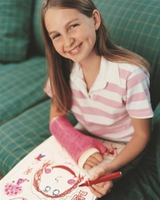
Children's Hospital of Philadelphia offers the full array of casting services, including waterproof liners for most cast types. We support patients and families throughout the casting experience to ensure they receive the most appropriate cast for their needs and are as comfortable as possible during their time in a cast.
What is a cast?
A cast holds a broken bone in place as it heals. Casts also help to prevent or decrease muscle contractions, and are effective at providing immobilization, especially after surgery.
Casts immobilize the joint above and the joint below the area that is to be kept straight and without motion. For example, a child with a forearm fracture will have a long arm cast to immobilize the wrist and elbow joints.
What are casts made of?
The outside, or hard part of the cast, is made from two different kinds of casting materials.
- Plaster (white in color)
- Fiberglass (comes in a variety of colors, patterns, and designs)
Cotton and other synthetic materials are used to line the inside of the cast to make it soft and to provide padding around bony areas, such as the wrist or elbow.
Special waterproof cast liners may be used under a fiberglass cast, allowing the child to get the cast wet. Consult your child's doctor for special cast care instructions for this type of cast.
What are the different types of casts?
Below is a description of the various types of casts, the location of the body they are applied, and their general function.
| Type of cast | Location | Uses |
| Short arm cast | Applied below the elbow to the hand | Forearm or wrist fractures. Also used to hold the forearm or wrist muscles and tendons in place after surgery |
| Long arm cast | Applied from the upper arm to the hand | Upper arm, elbow, or forearm fractures. Also used to hold the arm or elbow muscles and tendons in place after surgery |
| Arm cylinder cast | Applied from the upper arm to the wrist | To hold the elbow muscles and tendons in place after a dislocation or surgery |

| Type of cast | Location | Uses |
| Shoulder spica cast | Applied around the trunk of the body to the shoulder, arm, and hand | Shoulder dislocations or after surgery on the shoulder area |
| Minerva cast | Applied around the neck and trunk of the body | After surgery on the neck or upper back area |
| Short leg cast | Applied to the area below the knee to the foot | Lower leg fractures, severe ankle sprains/strains, or fractures. Also used to hold the leg or foot muscles and tendons in place after surgery to allow healing |
| Leg cylinder cast | Applied from the upper thigh to the ankle | Knee, or lower leg fractures, knee dislocations, or after surgery on the leg or knee area |
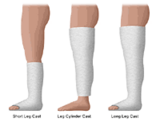
| Type of cast | Location | Uses |
| Club foot cast | Applied from the tips of the toes to just below the knee to the toes | To correct club foot |
| Patella tendon bearing (PTB) cast | Applied from below the knee in back of leg with a triangular cross section around patella to the toes | Used in the final stage of treatment for tibial fracture and to rehabilitate the knee after immobilization in a long-leg cast |
| Mehta cast | Applied from the chin to the hips | To correct a child’s spinal problem |
| Type of cast | Location | Uses |
| Unilateral hip spica cast | Applied from the chest to the foot on one leg | Thigh fractures. Also used to hold the hip or thigh muscles and tendons in place after surgery to allow healing |
| One and one-half hip spica cast | Applied from the chest to the foot on one leg to the knee of the other leg. A bar is placed between both legs to keep the hips and legs immobilized. | Thigh fracture. Also used to hold the hip or thigh muscles and tendons in place after surgery to allow healing |
| Bilateral long leg hip spica cast | Applied from the chest to the feet. A bar is placed between both legs to keep the hips and legs immobilized. | Pelvis, hip, or thigh fractures. Also used to hold the hip or thigh muscles and tendons in place after surgery to allow healing |
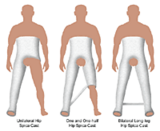
| Type of cast | Location | Uses |
| Short leg hip spica cast | Applied from the chest to the thighs or knees. | To hold the hip muscles and tendons in place after surgery to allow healing. |
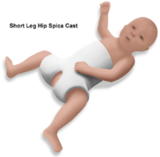
| Type of cast | Location | Uses |
| Abduction boot cast | Applied from the upper thighs to the feet. A bar is placed between both legs to keep the hips and legs immobilized. | To hold the hip muscles and tendons in place after surgery to allow healing. |
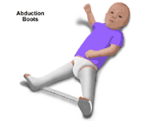
| Type of cast | Location | Uses |
| Thumb spica cast | Applied from the thumb and palm to the forearm | Immobilize the thumb and/or wrist |
| Ulnar gutter cast | Applied from the forearm to the fingertips, leaving the thumb, index finger and middle fingers mobile | Hand and finger fractures, and rheumatoid arthritis or osteoarthritis |
| Radial gutter cast | Applied from the forearm to the tips of the index and middle fingers | Distal radius fractures, metacarpal fractures, proximal phalanx fractures and other hand fractures |
How can my child move around while in a cast?
Assistive devices for children with casts include:
- Crutches
- Walkers
- Wagons
- Wheelchairs
- Reclining wheelchairs
Cast care instructions
Please consult your physician for specific instructions based on the cast type and casting material used.
- For casts with cotton lining, be sure to keep the cast clean and dry.
- For casts with a waterproof lining, it is recommended that you get the lining wet everyday to prevent bacteria buildup.
- Check for cracks or breaks in the cast.
- Rough edges can be padded to protect the skin from scratches.
- Do not scratch the skin under the cast by inserting objects inside the cast.
- Can use a hairdryer placed on a cool setting to blow air under the cast and cool down the hot, itchy skin. Never blow warm or hot air into the cast.
- Do not put powders or lotion inside the cast.
- Cover the cast while your child is eating to prevent food spills and crumbs from entering the cast, especially for young infants.
- Prevent small toys or objects from being put inside the cast.
- Elevate the cast above the level of the heart to decrease swelling.
- Encourage your child to move his or her fingers or toes to promote circulation.
- If the cast has an abduction bar, do not use the bar to lift or carry the child.
Older children with body casts may need to use a bedpan or urinal in order to go to the bathroom. Some tips to keep body casts clean and dry and prevent skin irritation around the genital area include the following:
- Use a diaper or sanitary napkin around the genital area to prevent leakage or splashing of urine.
- Place toilet paper inside the bedpan to prevent urine from splashing onto the cast or bed.
- Keep the genital area as clean and dry as possible to prevent skin irritation.
When to call your child's doctor
Contact your child's doctor or health care provider if your child develops one or more of the following symptoms:
- Fever greater than 101° F (38.3° C)
- Increased pain
- Increased swelling above or below the cast
- Complaints of numbness or tingling
- Drainage or foul odor from the cast
- Cool or cold fingers or toes
- If your child gets something stuck inside the cast